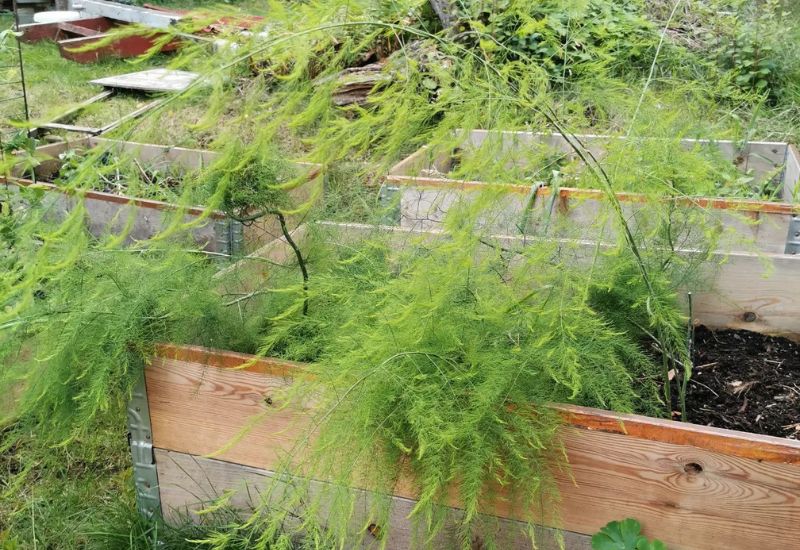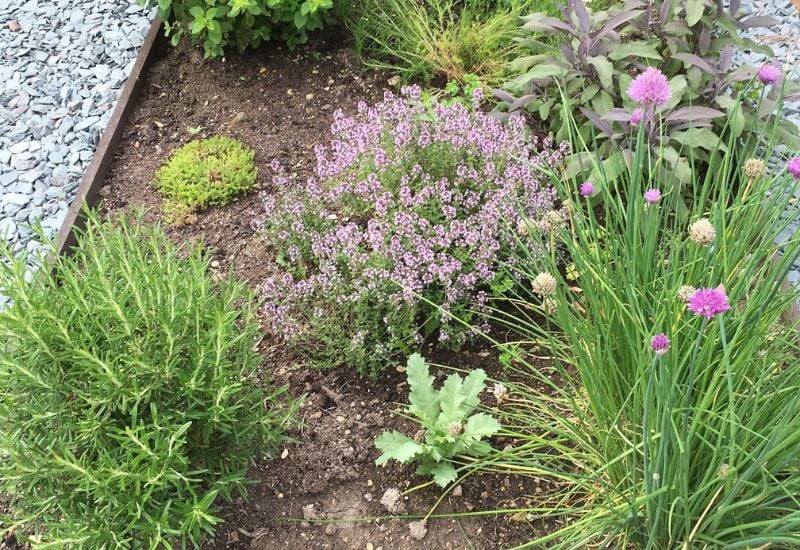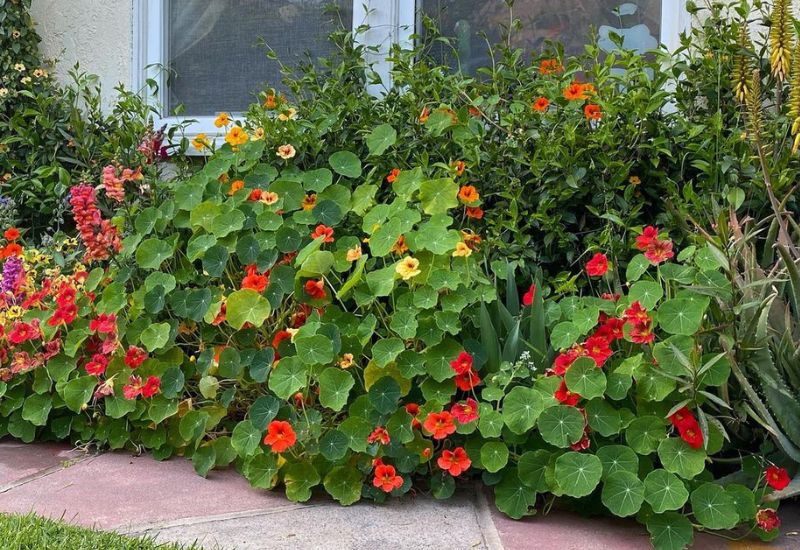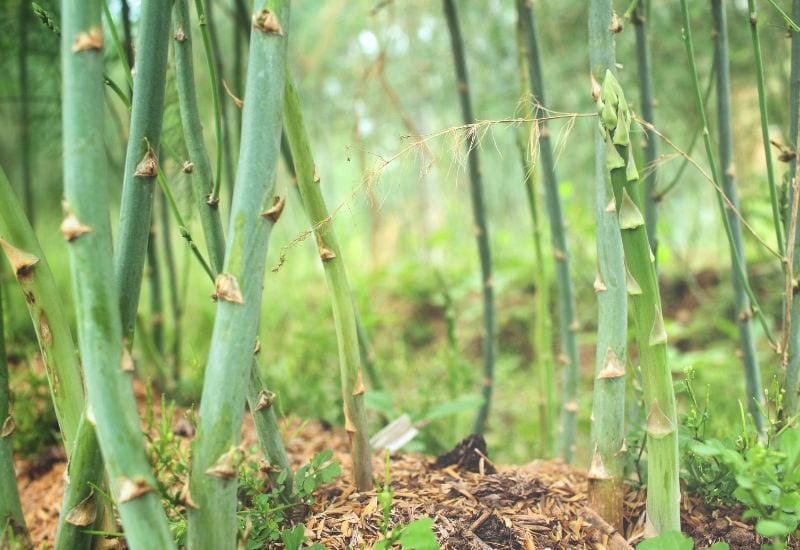
Companion planting is like a secret superpower for your asparagus crop. It’s all about swapping nutrients, scare away pests and inviting good bugs over to your asparagus party. It’s kind of a you-scratch-my-back-I-scratch-yours deal.
There are many plants that make excellent companions for asparagus. Your choices include vegetables, herbs, and even flowers.
One intriguing asparagus companion combination includes strawberries, rhubarb, and horseradish. As for herbs, asparagus pairs well with comfrey, cilantro, and dill. It also grows well when you plant alongside certain flowering plants like marigolds, nasturtiums, and members of the Aster family.
But, you know, just like people, some plants are not recommended plant partners for asparagus. If you’re not a fan of garlic and onions, asparagus is on your side. Keep them far away from your asparagus patch. And don’t even think about potatoes. Asparagus and potatoes? They’re simply not BFF material.
So, it’s important to ensure that all potential companions are compatible with asparagus before planting them together.
When deciding on plants to pair with your asparagus, it’s essential to select those that won’t compete for resources and potentially hinder the growth of your asparagus. It’s equally vital to avoid plants that could stunt your asparagus crop’s growth.
Ready to take the guesswork out? Awesome! This guide will give you the lowdown on the do’s and don’ts of companion planting with asparagus. We’ll dive into the best and worst neighbors for your asparagus, so you can make sure your garden is the place to be and your harvest is on point!
Why Should I Companion Plant my Asparagus?
Before we dive into the companion plants that are most and least compatible with asparagus, it is important to understand why companion plants are important in the first place. If you are unconvinced about whether you should be planting your asparagus with companions this year, take a look at these benefits it can offer your plants:
1: It can ward off diseases and pests
Companion plants are often cited for their ability to keep unwanted pests, viruses, and disease pathogens at bay. A major pest that goes after asparagus is the asparagus beetle and several plants, like tomatoes, emit certain chemicals in the soil that keeps them away.
Asparagus can take years to establish in a bed so it is important that during its first year after planting that you take all possible action to keep pests and disease at bay – and companion plants are just the ticket!
2: It bolsters nutrients in the soil
Asparagus are perennials that will return year after year, requiring the soil to have replenished its nutrient levels to ensure that your next crop has enough to feed on. Nitrogen, phosphorus, potassium, and magnesium are just a few of the nutrients that asparagus needs to have in abundance to thrive.
Companion plants for asparagus usually will either have different nutrient needs or replace nutrients in the soil to ensure a balance is maintained.
For example, beans and other legumes fix nitrogen by pulling it out of the air and soil and making it available for other plants to absorb – making them a good companion for asparagus.
3: Companion plants can provide shade and mulch
Asparagus beds can be very difficult to weed since the root systems are so fragile and close to the surface of the ground. It is risky to use common gardening tools like hoes or rakes to weed, so often you end up having to weed by hand- which takes a long time!
A good reason to companion plant is to provide your asparagus crops with a living mulch that will shade the soil, cool it down and reduce the evaporation of soil water, and can suppress the growth of weeds by taking up space.
Mulches are also a good way to prevent erosion, where the wind and rain can remove large amounts of bare soil over time until your garden is left with troughs instead of beds!
A good companion plant for this purpose is a low-growing plant such as clover, which covers the surface of the bed and also fixes nitrogen in the soil.
4: Allows you to grow more in a small space
Another common reason that people choose to companion plant their asparagus is to make the best use of their garden beds over the years. Since asparagus can take three years to establish itself, and then keep producing for many years after that, it makes sense to plant other compatible crops amongst it or at the end of the beds to make the most of your garden area.
It requires a balance between seasonality and nutrient needs to make sure you don’t plant crops that are going to compete with your asparagus.
For this reason, annuals are often a good category to pair with a perennial like asparagus, as you will harvest the whole plant come the end of every season and let the asparagus rest between rotations.
This practice of dispersing other types of plants in the same bed is called interplanting, and switching up which ones are being planted is called crop rotation.
Since asparagus is harvested typically in the spring, planting an annual in the nightshade family – like eggplant for example – makes sense for your space so that once your asparagus crop is finished you are still using the space for late summer – autumn harvest.
20 Best Companion Plants to Grow with Asparagus
Asparagus can benefit in many diverse ways from being planted with companions, but it is important to make sure you pick the right ones as not every plant is a friend to asparagus. These are the best 20 plants to plant near your asparagus to get your best crop yet:
1: Tomatoes

Asparagus is a perennial vegetable that will become established wherever you plant it. Intercropping tomatoes with asparagus makes efficient use of your space as the two crops are harvested at different times of the year – asparagus in the spring and tomatoes in mid to late summer.
Tomatoes benefit asparagus by deterring the asparagus beetle through a chemical they excrete (solanine), and asparagus keeps away the parasitic nematodes that can go after tomato roots.
How and when to plant tomatoes with your asparagus:
Plant tomatoes at either end of your asparagus beds to reap the benefits without doing any damage to their sensitive root systems. Plant the tomatoes in the late spring after the asparagus stalks have been harvested.
2: Cilantro
Cilantro, or coriander depending on your location, is a fantastic companion herb for asparagus due to its ability to repel pests like aphids and spider mites. In the first few years of getting established, asparagus is very vulnerable to attacks from pests and it is important to protect your young plants during this time period with pest-repelling herbs like cilantro.
How and when to plant cilantro with your asparagus:
In the early spring, before the asparagus harvest, or in the fall you can sow your cilantro seeds or plant your seedlings, depending on your climate. You can plant it under some taller companions (like tomatoes) to offer some shade to the leaves in very hot climates.
3: Basil

Basil is a great companion for many crops, and particularly for asparagus. Similar to many of the herbs on this list, basil offers the benefit of deterring pests through its pungent aroma.
Specifically, basil can offer great assistance in deterring asparagus beetles and can also offer the benefit of protecting major asparagus companions like tomatoes by deterring tomato hornworms.
How and when to plant basil with asparagus:
Basil should be planted as seedlings, or seeds if you are in a warm climate, in the early summer or late spring. Basil loves heat so make sure it is not shaded by anything else. You can plant it at the edges of asparagus beds leaving at least a couple of feet of space between your basil and asparagus heads.
4: Eggplant
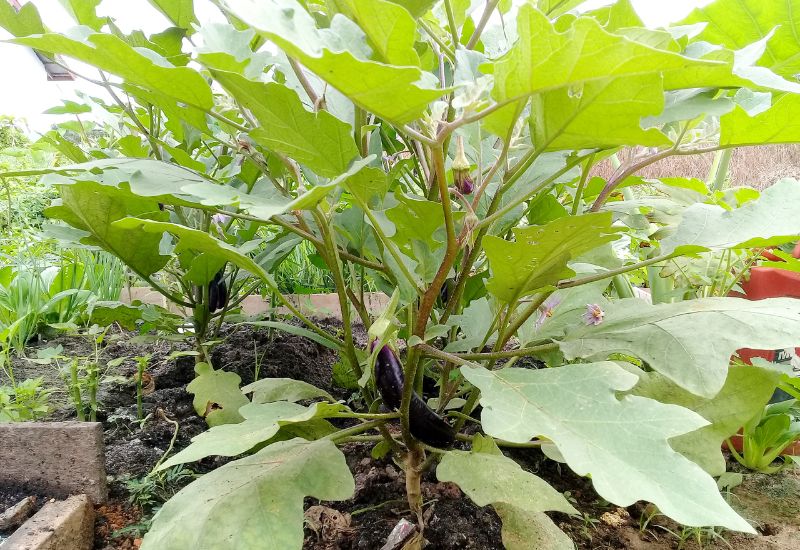
Eggplant is a nightshade, in the same family as tomatoes, and offers many of the same benefits as tomatoes to asparagus. Namely, repelling the asparagus beetle which is well known to eat away at the young fronds of developing asparagus plants and inhibit the growth of the crop over a longer period of time. Also like tomatoes, asparagus will return the flavor to eggplants and ward off root-knot nematodes.
How and when to plant with asparagus:
Plant your eggplant seedlings around the same time that you harvest your asparagus spears. Like tomatoes, it is best to plant them at either end of your beds, or whatever that equates to for your particular bed shape, so as to reduce any root interference with young asparagus plants.
5: Horseradish

Horseradish is a fantastic asparagus companion because it keeps away a class of insects known as “soft-bodied” such as slugs. Not only does horseradish have a pungent aroma but it also exudes a compound above and underground that deters these types of insects.
How and when to plant horseradish with asparagus:
Horseradish has very similar soil needs to asparagus which also makes it work well as a companion, and you can plant it in between asparagus crops. Just be careful when harvesting the root so you do not disturb the asparagus roots as well- pull straight up and out!
6: Parsley
Parsley helps asparagus by warding off the asparagus beetle but also supports all the flowering companions of asparagus as well. As asparagus does not necessarily attract many pollinators it is important to have companions that will support its companions, so that your tomato can produce fruit whilst acting as a guardian over your asparagus.
How and when to plant parsley with asparagus:
Plant parsley in the spring before harvesting your asparagus or in the fall at the end of the season. It is a cool season crop that will bolt if it becomes too hot, so it is a good idea to plant it on the borders of your asparagus bed under the shade of taller companions – like tomatoes.
7: Comfrey

Comfrey is a powerful companion to asparagus that repel pests such as spider mites and aphids and is also thought to ward off fungal disease pathogens that may infect your young spears.
In addition, they attract beneficial insects to your asparagus crop such as parasitic wasps, which will prey on the eggs of the asparagus beetle and prevent them from ravaging your young crop.
How and when to plant comfrey with asparagus:
Comfrey is a perennial and you can plant it amongst your asparagus a few weeks before the first frost. Don’t harvest too much from it in the first year of production but every year following make sure to trim it back so that it doesn’t take over your asparagus bed entirely.
8: Dill

Dill is a fragrant herb that, similar to other fragrant herbs on this list, repels common asparagus herbs with its pungent aroma. In particular, spider mites and aphids will steer clear of dill which makes it an effective companion for not only asparagus but many of asparagus’s other companions as well – like tomatoes.
How and when to plant dill with asparagus:
Although dill is a great companion it does have a long taproot and in its mature stages can become a competitor for certain soil nutrients, so it is best to keep dill nearby but confined to pots or raised beds.
9: Marigold
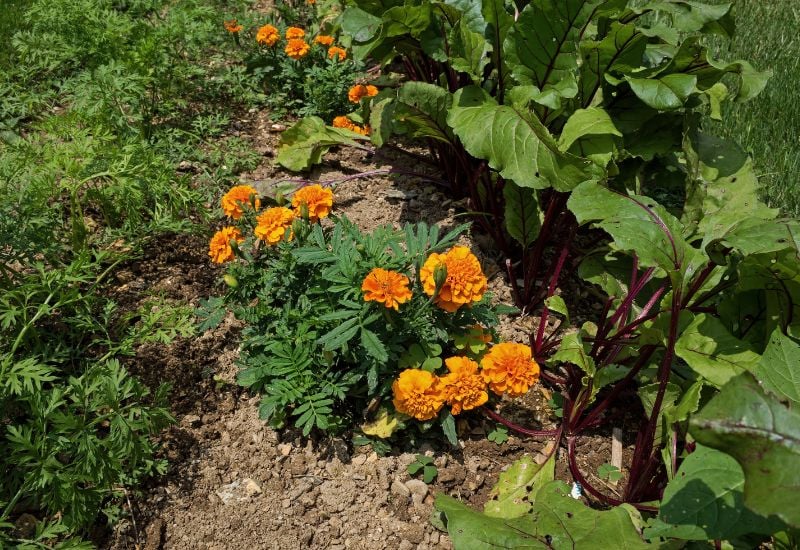
Marigolds keep common insect pests away from your asparagus but also nuisances like root nematodes and mammal pests, such as rabbits, from messing with your spears. As a flower, they are great for attracting pollinators and helping out other friends of asparagus with fruit production.
How and when to plant marigolds with asparagus:
Plant marigolds wherever you can find a spot – at the end of your asparagus beds or in and amongst the plants. Just make sure to leave a few feet of space between the nearest spears to prevent messing with the root system.
10: Nasturtiums
Nasturtiums are trailing edible flowers that deter beetles and ants and attract beneficial insects such as hoverflies. This is beneficial to your asparagus as hoverflies feast on aphids and other pesky pests that like to attack young asparagus plants.
How and when to plant nasturtiums with asparagus:
Nasturtiums are fantastic border flowers to your asparagus beds, at every corner or running along the sides. Their trailing vines can also be super helpful in shading weeds and suppressing their growth.
11: Clover

Clover is a nitrogen-fixing plant in the legume family that can benefit asparagus by acting as a living mulch and restoring soil nutrients. As clover is low-growing it can be highly beneficial when planted in asparagus beds as it won’t shade the spears but will help the soil retain water and suppress weed growth.
How and when to plant clover with asparagus:
Clover seeds should be scattered in the fall or early spring and they should be continuously cut back to prevent overgrowth or flowering. Don’t sow seeds too close to the spears themselves or it may interfere with the asparagus root system.
12: Beetroots
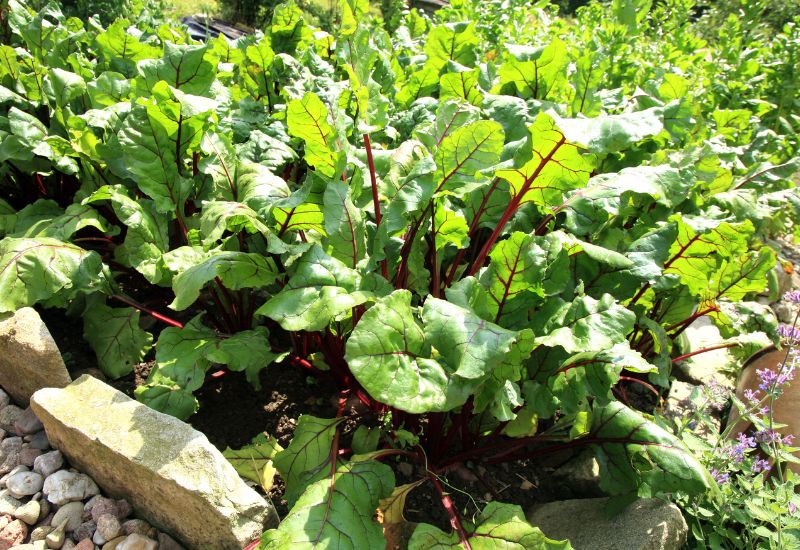
Beetroots are a good spatial companion for asparagus as they won’t take up a lot of space and have a relatively high turnover rate. They are a good crop to pair with your asparagus if you are pressed for space in your garden and are running out of room.
How and when to plant beetroots with asparagus:
Beet seeds can be sown in asparagus beds every six weeks throughout most of the growing season in cooler climates, and in the spring and fall in warmer climates. Leave at least 2 feet between spears and beets to prevent root disruption when harvesting your beets.
13: Lettuce

Lettuce and asparagus work well together in a shared bed as taller asparagus fronds offer shade to the lettuce and the lettuce suppresses weed growth around the asparagus.
Lettuce is prone to bolting quickly in the summer when it gets hot and planting the two together increases the lifespan of both.
How and when to plant lettuce with asparagus:
Sow lettuce seeds in and amongst the asparagus in the late spring for a summer crop. Make sure to plant horseradish nearby to ward off any of the slugs that lettuce might attract.
14: Strawberries

Strawberries and asparagus are fantastic companions as they follow the same growing season but in different layers of the soil strata. Strawberries will grow deeper roots than asparagus and therefore they can exist in close proximity without competing with each other.
How and when to plant strawberries with asparagus:
Plant asparagus and strawberries at the same time in either the spring or fall in a sunny spot of soil with excellent drainage. Make sure you give the strawberries enough room to spread out.
15: Rhubarb

Rhubarb leaves are famously poisonous but are what makes them an excellent friend of asparagus. The leaves contain something called oxalic acid, which repels insects such as whiteflies, thrips, and aphids and will benefit your asparagus for years to come.
How and when to plant rhubarb with asparagus:
Plant rhubarb near asparagus at the end of beds or in a raised bed nearby. Do not plant in and amongst the spears as rhubarb often grows quite large and may shade out the spears.
16: Mint

Mint is one of the most fragrant herbs you encounter in the garden, and it can be very helpful in keeping ants away from your asparagus. In addition, its purple flowers will attract a variety of pollinators that will help out the other companions of asparagus as well.
How and when to plant mint with asparagus:
Mint can be sown in the spring around the borders of your asparagus bed. Make sure to consistently trim it back throughout the year as mint is a notoriously fast grower that can take over your garden if left to its own devices.
17: Peppers
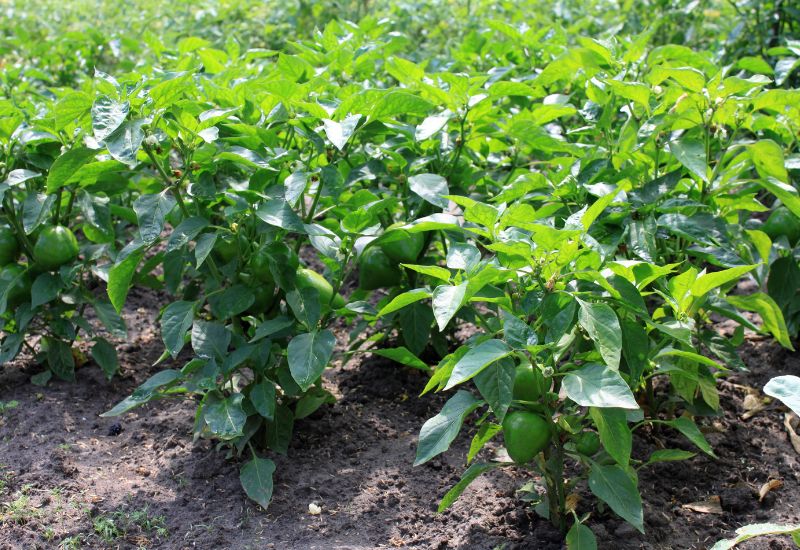
The same compound in peppers that gives these fruits their signature heat, called capsaicin, is a powerful insect repellent for common pests to asparagus like the spider mite. They also offer a nice staggered harvest for a single bed, as they are slower to grow than asparagus and are typically harvested in the late summer.
How and when to plant peppers with asparagus:
Transplant pepper seedlings around the borders or at the ends of your asparagus bed in the late spring. Be cautious of digging into the root system of the asparagus by leaving a few feet of space.
18: Spinach
Spinach is another low-growing, cool-season crop that likes to grow with asparagus for many of the same reasons as lettuce.
It will suppress weeds and retain moisture in the soil for your young asparagus spears and in return, the mature asparagus will shade the spinach to prevent bolting.
How and when to plant spinach with asparagus:
Sow spinach seeds in the early spring in rings around your asparagus spears, leaving enough room that the root systems won’t be competing with each other.
19: Sage
Sage is a good partner for asparagus as they both enjoy spots that receive full sun and have well-draining soil, and sage will repel moths, flies and beetles from your spears and other nearby companions. They also make a great culinary pair and complement each other in many dishes!
How and when to plant sage with asparagus:
Sage is a woody perennial so it is best to plant it before your asparagus, ideally one season before. In this way, the sage will be able to get established without competing with the asparagus and vice versa.
20: Thyme

Thyme is a great spatial companion to asparagus and also a pest deterrent. Many varieties of thyme are low-growing and won’t shade out your asparagus but will shade out any weeds growing in the bed.
The fragrance of the leaves and flowers will keep away worms and moths, which is especially important in the first years of your asparagus crop.
How and when to plant thyme with asparagus:
Depending on the variety thyme can be planted in and amongst your asparagus or at the ends of the beds. Any taller varieties should be given more space but creeping thyme can share the bed. Plant in the spring or fall.
3 Antagonistic Plants to Keep Away from Asparagus
Although asparagus has many companions it likes to grow alongside, it also has several antagonistic relationships with other common crops and you should make sure to keep them far apart. These crops can impact the growth of your asparagus plant due to competition for space and nutrients or they may release chemical secretions that stunt its growth.
Here are some plants you should avoid planting next to your asparagus beds:
1: Potatoes

Asparagus and potatoes are not good companions as their wandering root systems can compete and asparagus can stunt the growth of potatoes and limit the size they are able to reach.
In addition, they operate on very different seasonal schedules with potatoes requiring a longer time to grow and mature and requiring a lot of the bed to be dug up during the harvest – which can damage the perennial root systems of asparagus.
2: Alliums (onions, garlic, leek)
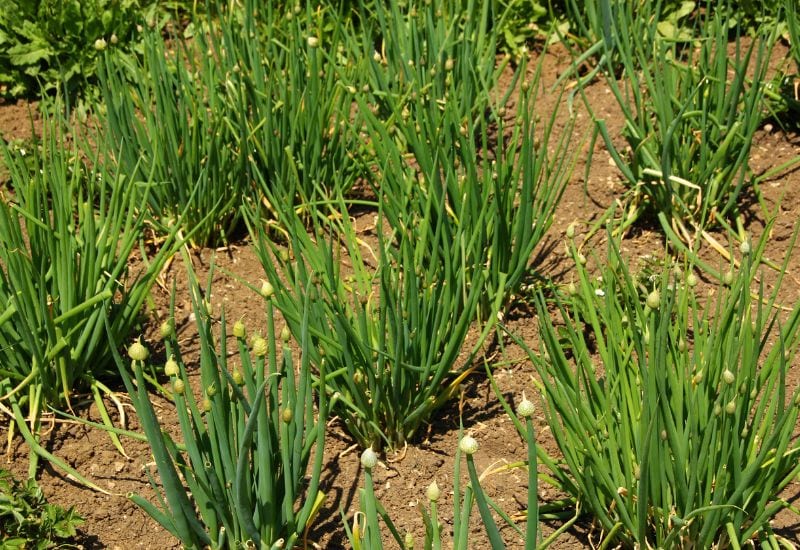
Any allium should be kept away from your asparagus beds as they can stunt the growth of your spears. This is particularly important during the first three years of your asparagus crop when the root system is developing.
Any onions, leeks, garlic, shallots or other allium varieties should be planted in other parts of the garden, ideally at least several meters away from any asparagus.
3: Carrots

Carrots, along with other similar root vegetables like parsnips, are not ideal companions for asparagus due to their shape and growth nature.
The deep root system of carrots creates direct competition and harvesting carrots will leave holes in the soil that can mess with the roots of your asparagus crop. Carrots also do not tend to thrive with a lot of the other companions on this list, especially with herbs like dill.
Companion Planting Makes Your Garden Stronger
Now that you know the best and worst companions for your asparagus plants, don’t stop there! Plant companions alongside all your fruits, vegetables, and flowers to create a diverse garden that is resilient to pests and diseases. Check out more of our guides on companion planting here to learn more about how to pair the best crops together for a thriving home garden.

Written By
Amber Noyes
Amber Noyes was born and raised in a suburban California town, San Mateo. She holds a master’s degree in horticulture from the University of California as well as a BS in Biology from the University of San Francisco. With experience working on an organic farm, water conservation research, farmers’ markets, and plant nursery, she understands what makes plants thrive and how we can better understand the connection between microclimate and plant health. When she’s not on the land, Amber loves informing people of new ideas/things related to gardening, especially organic gardening, houseplants, and growing plants in a small space.

